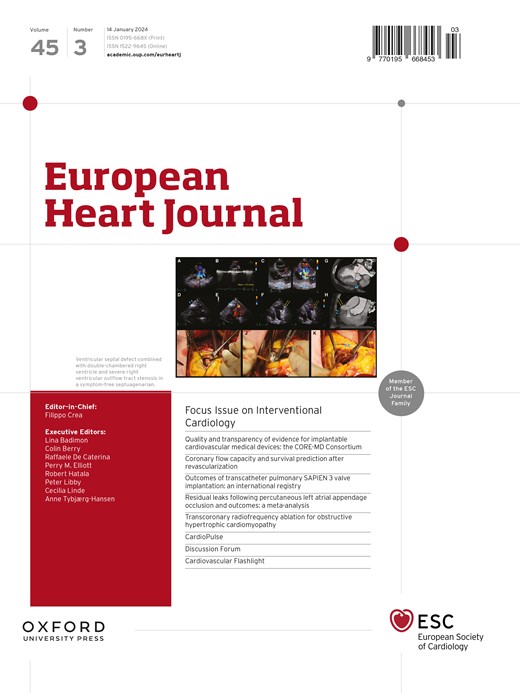Electrocardiogram-based deep learning to predict mortality in paediatric and adult congenital heart disease
IF 37.6
1区 医学
Q1 CARDIAC & CARDIOVASCULAR SYSTEMS
引用次数: 0
Abstract
Background and Aims Robust and convenient risk stratification of patients with paediatric and adult congenital heart disease (CHD) is lacking. This study aims to address this gap with an artificial intelligence-enhanced electrocardiogram (ECG) tool across the lifespan of a large, diverse cohort with CHD. Methods A convolutional neural network was trained (50%) and tested (50%) on ECGs obtained in cardiology clinic at the Boston Children’s Hospital to detect 5-year mortality. Temporal validation on a contemporary cohort was performed. Model performance was evaluated using the area under the receiver operating characteristic and precision-recall curves. Results The training and test cohorts composed of 112 804 ECGs (39 784 patients; ECG age range 0–85 years; 4.9% 5-year mortality) and 112 575 ECGs (39 784 patients; ECG age range 0–92 years; 4.6% 5-year mortality from ECG), respectively. Model performance (area under the receiver operating characteristic curve 0.79, 95% confidence interval 0.77–0.81; area under the precision-recall curve 0.17, 95% confidence interval 0.15–0.19) outperformed age at ECG, QRS duration, and left ventricular ejection fraction and was similar during temporal validation. In subgroup analysis, artificial intelligence-enhanced ECG outperformed left ventricular ejection fraction across a wide range of CHD lesions. Kaplan–Meier analysis demonstrates predictive value for longer-term mortality in the overall cohort and for lesion subgroups. In the overall cohort, precordial lead QRS complexes were most salient with high-risk features including wide and low-amplitude QRS complexes. Lesion-specific high-risk features such as QRS fragmentation in tetralogy of Fallot were identified. Conclusions This temporally validated model shows promise to inexpensively risk-stratify individuals with CHD across the lifespan, which may inform the timing of imaging/interventions and facilitate improved access to care.基于心电图的深度学习预测儿童和成人先天性心脏病的死亡率
背景和目的 对儿童和成人先天性心脏病(CHD)患者进行可靠、便捷的风险分层尚属空白。本研究旨在利用人工智能增强型心电图(ECG)工具,对一大批不同类型的先天性心脏病患者进行全生命周期的风险分层。方法 在波士顿儿童医院心脏科门诊获得的心电图上对卷积神经网络进行训练(50%)和测试(50%),以检测 5 年死亡率。在当代队列中进行了时间验证。使用接收者操作特征曲线下面积和精确度-召回曲线评估模型性能。结果 训练队列和测试队列分别包括 112 804 张心电图(39 784 名患者;心电图年龄范围为 0-85 岁;5 年死亡率为 4.9%)和 112 575 张心电图(39 784 名患者;心电图年龄范围为 0-92 岁;心电图 5 年死亡率为 4.6%)。模型性能(接收者操作特征曲线下面积为 0.79,95% 置信区间为 0.77-0.81;精确度-调用曲线下面积为 0.17,95% 置信区间为 0.15-0.19)优于心电图年龄、QRS 持续时间和左心室射血分数,且在时间验证过程中表现相似。在亚组分析中,人工智能增强心电图在各种冠心病病变中的表现优于左心室射血分数。Kaplan-Meier 分析表明,人工智能增强心电图对总体队列和病变亚组的长期死亡率具有预测价值。在总体队列中,心前区导联 QRS 波群最为突出,其高风险特征包括宽波幅和低波幅 QRS 波群。此外,还发现了法洛四联症 QRS 分段等病变特异性高风险特征。结论 这一经过时间验证的模型有望以低成本对整个生命周期中的冠心病患者进行风险分层,从而为造影/干预时机的选择提供依据,并有助于改善医疗服务的可及性。
本文章由计算机程序翻译,如有差异,请以英文原文为准。
求助全文
约1分钟内获得全文
求助全文
来源期刊

European Heart Journal
医学-心血管系统
CiteScore
39.30
自引率
6.90%
发文量
3942
审稿时长
1 months
期刊介绍:
The European Heart Journal is a renowned international journal that focuses on cardiovascular medicine. It is published weekly and is the official journal of the European Society of Cardiology. This peer-reviewed journal is committed to publishing high-quality clinical and scientific material pertaining to all aspects of cardiovascular medicine. It covers a diverse range of topics including research findings, technical evaluations, and reviews. Moreover, the journal serves as a platform for the exchange of information and discussions on various aspects of cardiovascular medicine, including educational matters.
In addition to original papers on cardiovascular medicine and surgery, the European Heart Journal also presents reviews, clinical perspectives, ESC Guidelines, and editorial articles that highlight recent advancements in cardiology. Additionally, the journal actively encourages readers to share their thoughts and opinions through correspondence.
 求助内容:
求助内容: 应助结果提醒方式:
应助结果提醒方式:


